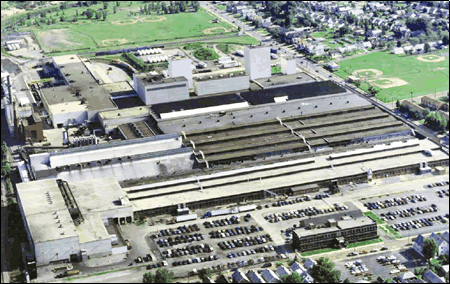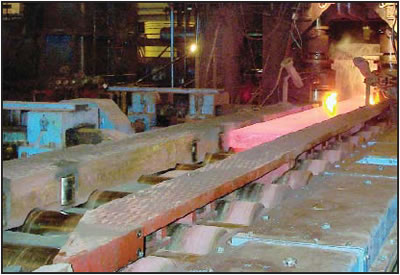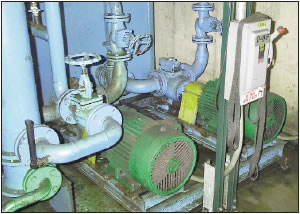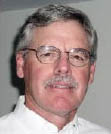![]() Available in PDF format [315 Kb]
Available in PDF format [315 Kb]
- Are your motors efficient?
- Rewinding Didn't Make Sense
- Copper-Wound Transformers Provide More Savings
 Outokumpu Copper Products plant in Buffalo.
Outokumpu Copper Products plant in Buffalo.Outokumpu Copper Products (OCP), Buffalo, New York, is a leading U.S. manufacturer of copper, brass and other copper alloys. The company supplies precision rolled sheet and strip products for the building construction, electrical and electronics, automotive, ordnance and telecommunications industries. OCP is also a member of the Copper Development Association Inc. (CDA) and actively supports CDA's campaign to promote electrical energy efficiency. Not surprisingly, OCP has adopted a number of CDA's recommendations for saving energy, especially when it comes to electric motors.
OCP's million-square-foot Buffalo plant is one of the largest brass mills in the country. It is also one of the most efficient, thanks to continuing upgrades in equipment and systems. The current focus is on reducing operating costs. The most important objective at OCP will always be to maintain our high level of product quality, says Todd Heusner, vice president. But these days, the three most important phrases are reduce costs, reduce costs and reduce costs!
OCP recognized that, if you really want to reduce costs, energy consumption is one of the first places to look, and if you want to reduce energy consumption, one of the first things to zero in on is your inventory of electric motors. Why motors? Because, according to the U.S. Department of Energy, motor-driven systems consume about 65% of the electric power used in industrial facilities.
OCP operates more than 500 motors at its Buffalo plant. They range in size up to 7,000 hp. The largest ones, which are DC-powered, drive the plant's rolling mills (Figure 1). We'll say more about them later. More important from an energy consumption standpoint are the plant's many AC motors. They range mainly between 5 hp and 100 hp in size, and it's these motors that enable the company to put a serious dent in its operating costs. The plan is simple: install or replace as many motors as practical with the highest-efficiency models available.
 Figure 1. A slab of hot brass leaves the hot rolling mill at Outokumpu Copper Products. DC motors up to 7,000 hp drive the company's several mills, but OCP realizes its largest energy savings in the many smaller AC motors that it is replacing with NEMA Premium® models.
Figure 1. A slab of hot brass leaves the hot rolling mill at Outokumpu Copper Products. DC motors up to 7,000 hp drive the company's several mills, but OCP realizes its largest energy savings in the many smaller AC motors that it is replacing with NEMA Premium® models.Our company motor policy is straightforward, explains Christian Wojciechowski. Chris is OCP's director of purchasing, a job he assumed after being a manager in the mill for 21 years. If a 50-hp or smaller motor fails, we don't bother to rewind it. We just replace it with a NEMA Premium® motor. If a motor larger than 50-hp fails, we look at the economics, and if the cost of repair/rewind is higher than 50% of the cost of a new motor, we buy the new motor. Eventually, we plan to use NEMA Premium® motors wherever we can. The only exceptions are special-purpose motors, to which EPAct and NEMA Premium® standards don't apply.
EPAct refers to the Energy Policy Act of 1992, which took effect in 1997. The law requires certain types of motors sold in the USA to meet minimum electrical efficiency standards that, in most cases, are between one and four percentage points higher than so-called standard-efficiency motors. Nominal efficiencies required to meet EPAct standards are spelled out in Table 12-11 of the National Electrical Manufacturers Association publication, NEMA MG 1-1998 R3.1
NEMA Premium® motors meet the even higher standards listed in Tables 12-12 and 12-13 of NEMA MG 1-1998 R3. In general, efficiencies for these motors are one to two percentage points higher than those required under EPAct. The NEMA Premium® motors program covers motors that are single- speed; polyphase; 2-, 4- or 6-pole; squirrel cage induction; NEMA design A or B, continuous rated, and extends the EPAct upper range from 200 hp to 500 hp. The motors gain their top performance largely as a result of more than 20% additional copper in their windings. The additional copper reduces resistive losses and thereby raises efficiency.2 NEMA Premium® units represent the highest efficiency motors currently available.
Back to TopAre your motors efficient?
To check whether your motors meet the NEMA Premium® standard, compare nameplate efficiency ratings with the data in Table 1, which lists efficiencies for five popular sizes in open drip proof (ODP) and totally enclosed fan-cooled (TEFC) models. A comparison of nominal EPAct efficiencies and nominal NEMA Premium® efficiencies is also available at CEE site.3
| hp | Standard- Efficiency Motors % Average Efficiency At 100% Load |
EPAct Energy-Efficiency Motors % Nominal Efficiency at 100% Load |
NEMA Premium® Motors ODP Motors % Nominal (% Minimum) Efficiency at 100% Load |
NEMA Premium® Motors TEFC Motors % Nominal (% Minimum) Efficiency at 100% Load |
||||
|---|---|---|---|---|---|---|---|---|
| 2-pole | 4-pole | 6-pole | 2-pole | 4-pole | 6-pole | |||
| 5 | 84.0 | 87.5 | 86.5 (84.0) | 89.5 (84.0) | 89.5 (87.5) | 88.5 (86.5) | 89.5 (87.5) | 89.5 (87.5) |
| 10 | 86.7 | 89.5 | 89.5 (87.5) | 91.7 (90.2) | 91.7 (90.2) | 90.2 (88.5) | 91.7 (90.2) | 91.0 (89.5) |
| 25 | 89.9 | 92.4 | 91.7 (90.2) | 93.6 (92.4) | 93.0 (91.7) | 91.7 (90.2) | 93.6 (92.4) | 93.0 (91.7) |
| 50 | 91.6 | 93.0 | 93.0 (91.7) | 94.5 (93.6) | 94.1 (93.0) | 93.0 (90.7) | 94.5 (93.6) | 94.1 (93.0) |
| 100 | 92.2 | 94.5 | 93.6 (92.4) | 95.4 (94.5) | 95.0 (94.1) | 94.1 (93.0) | 95.4 (95.4) | 95.0 (94.1) |
| Source: National Electrical Manufacturers Association. For full table, see CEE site. | ||||||||
A few percentage points doesn't sound like a lot, but it makes sense when you consider that an industrial motor operating at high duty cycles can consume up to 20 times its purchase price in electrical energy every year. It's the energy, not the motor, that's expensive, and even small cuts in power consumption can make a big difference in the long run.
For example, consider the pair of 100-hp Toshiba EQP III motors (Figure 2) that drive lubricant pumps on one of OCP's cold-finishing mills. They are NEMA Premium® rated, with efficiencies of 95.0% at 100% and 75% of full load, and 94.7% at 50% load. Cost per motor after distributor discount was $3,425. OCP installed them several years ago, replacing two standard-efficiency motors dating back to the 1980s. Operating at 75% of full load, each motor consumes 474,224 kWh/y based on an 8,000-hour duty cycle. That amount of power costs OCP $28,453 at its usual utility rate, around $0.06/kWh. (The peak rate is as high as $0.10.)
 Figure 2. Two 100-hp NEMA Premium® motors drive lubricant pumps on one of OCP's rolling mills. Operating at 95.0% efficiency (75% of full load) the Toshiba EQP III motors save the company 16,700 kWh per year each. Payback of the cost of the new motors compared with rebuilding existing standard-efficiency motors was less than two years. In addition, each motor reduces carbon dioxide emissions by almost 11 tons annually.
Figure 2. Two 100-hp NEMA Premium® motors drive lubricant pumps on one of OCP's rolling mills. Operating at 95.0% efficiency (75% of full load) the Toshiba EQP III motors save the company 16,700 kWh per year each. Payback of the cost of the new motors compared with rebuilding existing standard-efficiency motors was less than two years. In addition, each motor reduces carbon dioxide emissions by almost 11 tons annually.Now compare those numbers with those for the old standard- efficiency motors that OCP replaced using a handy piece of software called MotorMaster+. Washington State University's Energy Program developed this easy-to-use application for the U.S. Department of Energy. It contains cost, efficiency and operating data on hundreds of motors and uses that information to calculate and compare life-cycle costs based on user-selected parameters. The software can also compare the cost of rewinding old motors with the cost of new motors meeting EPAct and NEMA Premium® standards. MotorMaster+ software is available by request at AMO Tools Help Desk.4
Table 2 summarizes energy savings for OCP's lubricant pump motors. Operating at 90.2% efficiency at 75% load, each motor consumed 490,924 kWh/y costing $29,455; i.e., $1,002 more per year than the cost to operate the NEMA Premium® motors. The existing motors could have been rewound at a cost of $1,775 apiece. Volland Electric, OCP's motor distributor in this case, even guaranteed that its rewinds would not have resulted in any loss in efficiency. That's possible when working with a quality full-service shop like Volland Electric, but motors cannot exceed their original efficiency value no matter how carefully the rewinding is done.
| Efficiency at 75% of Full Load | Rebuild/ Purchase Cost | Annual Power Use | Annual Operating Cost, 8,000h @ $0.06/kWh | Annual Operating Savings | Payback | |
|---|---|---|---|---|---|---|
| Standard- Efficiency Motor | 90.2% | $1,775 | 490,924 | $29,455 | — | — |
| NEMA Premium®- Efficiency Motor |
95.0% | $3,425 | 474,224 | $28,453 | $1,002 | 1.65 years |
Rewinding Didn't Make Sense
Comparing the cost of rewinding the old motors with the cost of new NEMA Premium® motors, and factoring in the energy savings the new motors accrue, the NEMA Premium® motors paid for themselves in 1.47 years based on actual experience, faster than the 1.65 years predicted by MotorMaster+ (Table 2). Because OCP bought two premiumefficiency motors, that's equivalent to earning a free one every 9 months, and the savings keep piling up, year after year. The 1.47-year payback alone is something that Chris Wojciechowski and every other purchasing director in the country appreciates. And, because the new motors reduce annual carbon dioxide emissions from the company's electric utility by nearly 22 tons, the environment benefits as well.
Finally and this is often overlooked a top-of-the-line NEMA Premium® motor will most likely last longer and require less maintenance than a rewound unit. That added reliability adds to the savings by reducing the likelihood of an unscheduled shutdown.
Back to TopCopper-Wound Transformers Provide More Savings
Neither the EPAct nor the NEMA Premium® standard covers DC motors like the ones that power OCP's rolling mills, but the company found a way to reduce costs here, too. In this case, they replaced the inefficient motor-generator sets that provide DC motors with modern, solid-state power supplies. A vital part of those power supplies are their high-efficiency, 100% copper-wound transformers. That was a major upgrade, recalls Jim Tuohy, Volland Electric's senior applications engineer. We replaced 11 M-G sets with solid drives, all with copper-wound transformers, and saved the company a lot of money. And, because of its reduced energy demand, the company qualified for a $248,000 rebate.
OCP is currently in the process of replacing its other old, PCB-contaminated transformers as part of its general environmental improvement program. And, yes, all the new transformers will be copper-wound, as well. The company won't buy anything else!
Copper, the sure way to cut costs.
Back to TopThe Principals
 Todd Heusner is vice president and general manager, Regional Products Business, Outokumpu Copper Products. An engineer with 23 years experience in the copper products industry, Mr. Heusner emphasizes energy efficiency as an important component of cost reduction. Outokumpu Copper Products is a leading supplier of precision-rolled copper and copper alloy products in sheet and strip forms. For additional information, see Outokumpu site or call (716) 879-6700.
Todd Heusner is vice president and general manager, Regional Products Business, Outokumpu Copper Products. An engineer with 23 years experience in the copper products industry, Mr. Heusner emphasizes energy efficiency as an important component of cost reduction. Outokumpu Copper Products is a leading supplier of precision-rolled copper and copper alloy products in sheet and strip forms. For additional information, see Outokumpu site or call (716) 879-6700. Christian Wojciechowski is director of purchasing at Outokumpu Copper Products. He also served as a manager in the company's mill for 21 years, so he appreciates both the savings and the reliability that copper provides. Chris can be reached at (716) 879-6862, or [email protected].
Christian Wojciechowski is director of purchasing at Outokumpu Copper Products. He also served as a manager in the company's mill for 21 years, so he appreciates both the savings and the reliability that copper provides. Chris can be reached at (716) 879-6862, or [email protected]. Jim Tuohy is senior applications engineer at Volland Electric, Buffalo, New York. Volland, an ISO 9002-certified company, is the largest stocking motor distributor in the Niagara Frontier. In addition to motors and motor rebuilding, the company offers repair and sales of a large variety of electrical equipment. Contact Jim at (716) 656-9900, or [email protected].
Jim Tuohy is senior applications engineer at Volland Electric, Buffalo, New York. Volland, an ISO 9002-certified company, is the largest stocking motor distributor in the Niagara Frontier. In addition to motors and motor rebuilding, the company offers repair and sales of a large variety of electrical equipment. Contact Jim at (716) 656-9900, or [email protected].
Footnotes
 Motors covered under EPAct are of the general purpose, T-frame, single speed squirrel cage, induction type; 230/460-V, NEMA Designs A or B, continuous rated, 60 Hz, from 1 200 hp, 2-, 4- and 6-pole (3600, 1800 and 1200 rpm), open and enclosed. EPAct doesn't address special purpose motors or motors of sizes, frames, speeds or voltages other than those listed.
Motors covered under EPAct are of the general purpose, T-frame, single speed squirrel cage, induction type; 230/460-V, NEMA Designs A or B, continuous rated, 60 Hz, from 1 200 hp, 2-, 4- and 6-pole (3600, 1800 and 1200 rpm), open and enclosed. EPAct doesn't address special purpose motors or motors of sizes, frames, speeds or voltages other than those listed. An instructive CD-ROM on motors can be ordered free of charge by calling 888-480-4276. Premium-efficiency motors may have characteristics different from standard- or EPAct-efficiency motors, such as starting current, torque, speed, etc. All engineering parameters must be taken into account when considering replacement.
An instructive CD-ROM on motors can be ordered free of charge by calling 888-480-4276. Premium-efficiency motors may have characteristics different from standard- or EPAct-efficiency motors, such as starting current, torque, speed, etc. All engineering parameters must be taken into account when considering replacement. Use of the NEMA Premium™ term and label is voluntary, even among NEMA members. Lack of a NEMA Premium™ label does not necessarily mean that a particular motor does not meet the standards. It pays to check the efficiency rating of a particular motor against the published NEMA standards.
Use of the NEMA Premium™ term and label is voluntary, even among NEMA members. Lack of a NEMA Premium™ label does not necessarily mean that a particular motor does not meet the standards. It pays to check the efficiency rating of a particular motor against the published NEMA standards. USA addresses only.
USA addresses only.
